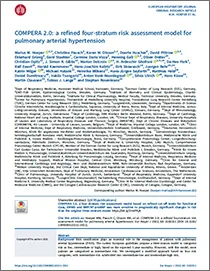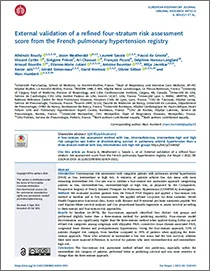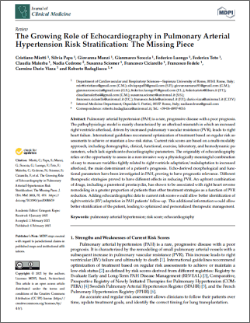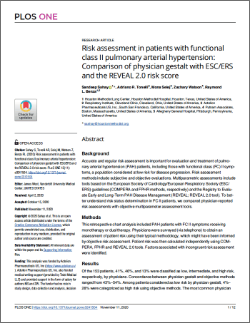Published Studies in PAH
Stay up to date
Recent publications on best practices in pulmonary arterial hypertension (PAH) patient monitoring and treatment.

Guidelines for the Echocardiographic Assessment of the Right
Heart in Adults and Special Considerations in Pulmonary
Hypertension: Recommendations from the American Society of
EchocardiographyMukherjee M, et al.
J Am Soc Echocardiogr. 2025;38(3):141-186.
Study design
- Updated guidelines based on close review of published data, including new values and severity gradings, with emphasis on right heart health as it relates to PVD at risk for PH
- Replaces previous 2010 ASE right heart guidelines
Key insights
- Describes how the right heart adapts to PVD, particularly functional and structural changes because of increased afterload
- Defines acoustic windows and imaging views and parameters essential for right heart evaluation, including reference values for normal and abnormal, while recommending TV, PV, and PH disease considerations
- Standardizes right heart imaging and reporting for clinicians
- Emphasizes the crucial role of Echo in screening, detection, monitoring of treatment, and prognosis of PH

Virtual Echocardiography Screening Tool to Differentiate
Hemodynamic Profiles in Pulmonary HypertensionVaidya A, et al.
Pulm Circ. 2020;10(3):1-10.
Study design
- Retrospective review of initial cohort of 96 patients with PH who received a RHC and Echo within 1 year of each other and validation cohort of 30 patients with PH
- Patients were scored on presence/absence of VEST parameters, including mitral E:e’, qualitative LA size, and presence of systolic intraventricular septal flattening
Key insights
- Positive VEST scores were both sensitive (80.0%) and specific (75.6%) for presence of PAH, separating potential PAH from left heart disease; a +3 score was highly specific (92.7%) and predicted PAH at 88.0%
- Information from standard Echo reports applied to VEST scoring supported consistent clear screening of patients with potential for PAH, allowing for a timely referral to PH Expert Centers and precise use of invasive RHCs for patients with greater potential for having PAH

COMPERA 2.0: A Refined 4‑Stratum Risk Assessment Model
for Pulmonary Arterial HypertensionHoeper MM, et al.
Eur Respir J. 2022;60(1):2102311.
Study design
- Analysis of 1655 patients from the COMPERA database to evaluate a modified risk stratification using 4-strata model (COMPERA 2.0) with refined cutoff levels for FC, 6MWD, and BNP/NT-pro-BNP
- Patients selected in this study were newly diagnosed with any form of PAH and had at least 1 follow-up assessment available
Key insights
- Most patients were categorized as intermediate risk with the 3-strata model; this group was further divided into intermediate-low and intermediate-high risk groups according to the 4-strata model
- Changes in risk from baseline to first follow-up occurred in 49.2% of patients categorized by the 4-strata model compared with 31.1% with the 3-strata model
- A 4-strata risk model yielded more nuanced separation and was able to predict differentiated long-term survival compared with the 3-strata model

External Validation of a Refined 4‑Stratum Risk
Assessment Score From the French Pulmonary Hypertension
RegistryBoucly A, et al.
Eur Respir J. 2022;59(6):2102419.
Study design
- Retrospective analysis of prospectively collected data from 2879 patients with Group 1 PAH who were enrolled in the French PAH Registry between 2009 and 2020 to validate a 4-strata risk assessment approach
- Patients were categorized as low, intermediate-low, intermediate-high, or high risk per COMPERA Registry investigators
Key insights
- The 4-strata approach performed better than a 3-strata method for predicting mortality
- Applying the 4-strata approach, 53% of patients changed risk category from baseline compared with 39% of patients when using the 3-strata approach
- In comparison with the 3-strata risk assessment, the 4-strata approach was more sensitive to change, refined risk prediction, and had better survival predictions

The Growing Role of Echocardiography in Pulmonary Arterial
Hypertension Risk Stratification: The Missing PieceMiotti C, et al.
J Clin Med. 2021;10(4):619.
Study design
- Literature review on the use of Echo parameters in PAH and their current and future roles in determining patient prognosis
Key insights
- Echo-derived parameters show how a patient’s RV is adapting to increased afterload and can indicate disease progression before worsening symptoms or 6MWD
- Many Echo parameters have proven to be prognostic in PAH, including right heart reverse remodeling, a recently identified key parameter in evaluating a patient’s response to PAH therapy
- Adding Echo parameters to current risk assessment tools could allow for improved prognostication and optimized therapeutic management

Risk Assessment in Patients With Functional Class II Pulmonary
Arterial Hypertension: Comparison of Physician Gestalt With
ESC/ERS and the REVEAL 2.0 Risk ScoreSahay S, et al.
PLoS One. 2020;15(11):e0241504.
Study design
- Retrospective chart analysis of 153 FC II patients on mono- or dual therapy (ERA/PDE-5i)
- PAH-experienced physicians were surveyed for their gestalt assessment of risk; then risk was calculated independently using COMPERA, the French Noninvasive method, and REVEAL 2.0
Key insights
- More than half of FC II patients were classified as intermediate- or high-risk status when risk was formally calculated
- Factors that led to incongruent risk assessments included less frequent Echos at follow-up, higher physician-reported patient activity level, and HCP-reported patient symptomatic stability
Need more information?
Find practical tools and resources to help you and your patients with PAH.
View Additional Resources